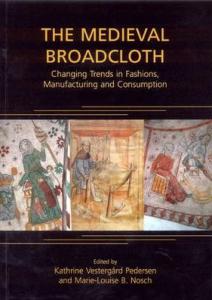The Medieval Broadcloth: Changing Trends in Fashions, Manufacturing and Consumption
CODICE: ISBN 1842173812 EAN 9781842173817
AUTORE/CURATORE/ARTISTA :
Edited by: Kathrine Vestergård Pedersen, Marie-Louise B. Nosch Contributors: Kathrine Vestergård Pedersen, Marie-Louise B. Nosch, John Munro, Carsten Jahnke, Heini Kirjavainen, Riina Rammo, Jerzy Maik, Camilla Luise Dahl, Anton Reurink
EDITORE/PRODUTTORE : Oxbow Books
COLLANA/SERIE : Ancient Textiles Series, 6
DISPONIBILITA': In esaurimento
TITOLO/DENOMINAZIONE:
The Medieval Broadcloth: Changing Trends in Fashions, Manufacturing and Consumption
PREZZO : EUR 110,00€
CODICE :
ISBN 1842173812
EAN 9781842173817
AUTORE/CURATORE/ARTISTA :
Edited by: Kathrine Vestergård Pedersen, Marie-Louise B. Nosch Contributors: Kathrine Vestergård Pedersen, Marie-Louise B. Nosch, John Munro, Carsten Jahnke, Heini Kirjavainen, Riina Rammo, Jerzy Maik, Camilla Luise Dahl, Anton Reurink
EDITORE/PRODUTTORE:
Oxbow Books
COLLANA/SERIE:
Ancient Textiles Series, 6
ANNO:
2010
DISPONIBILITA':
In esaurimento
CARATTERISTICHE TECNICHE:
XII-160 pages
27 colour illustrations, 22 b&w illustrations
Paperback
cm 17 x 24 x 0,9
gr 420
DESCRIZIONE:
Publisher's description and from the back cover:
The eight papers presented here provide a useful introduction to medieval broadcloth, and an up-to-date synthesis of current research. The word broadcloth is nowadays used as an overall term for the woven textiles mass-produced and exported all over Europe. It was first produced in Flanders as a luxurious cloth from the 11th century and through out the medieval period. Broadcloth is the English term, Laken in Flemish, Tuch in German, Drap in French, Klaede in the Scandinavian languages and Verka in Finish. As the concept of broadcloth has deriving from the written sources it can not directly be identified in the archaeological textiles and therefore the topic of medieval broadcloth is very suitable as an interdisciplinary theme.
The first chapter (John Munro) presents an introduction to the subject and takes the reader through the manufacturing and economic importance of the medieval broadcloth as a luxury item. Chapter two (Carsten Jahnke) describes trade in the Baltic Sea area, detailing production standards, shipping and prices. Chapters three, four and five (Heini Kirjavainen, Riina Rammo and Jerzy Maik) deal with archaeological textiles excavated in the Baltic, Finland and Poland. Chapters six and seven (Camilla Luise Dahl and Kathrine Vestergàrd Pedersen) concern the problems of combining the terminology from the written sources with archaeological textiles. The last chapter reports on an ongoing reconstruction project; at the open air museum in Eindhoven, Holland, Anton Reurink has tried to recreate a medieval broadcloth based on written and historical sources. During the last few years he has reconstructed the tool for preparing and spinning wool, and a group of spinners has produced a yarn of the right quality. He subsequently wove approximately 20 metres of cloth and conducted the first experiment with foot-fulling. The volume demonstrates how interdisciplinary work of historians, achaelogists, textile experts and craftspeople provide bew perspectives in medieval history.
Contents:
page VII List oo contributors
IX Introduction by Kathrine Vestergård Pedersen and Marie-Louise B. Nosch
1 1. Three Centuries of Luxury Textile Consumption in the Low Countries and England, 1330-1570: Trends and Comparisons of Real Values of Woollen Broadcloths (Then and Now), by John Munro
74 2. Some Aspects of Medieval Cloth Trade in the Baltic Sea Area, by Carsten Jahnke
90 3. A Finnish Archaeological Perspective on Medieval Broadcloth, by Heini Kirjavainen
99 4. Searching for Broadcloth in Tartu (14th-15th century), by Riina Rammo
109 5. The Influence of Hanseatic Trade on Textile Production in Medieval Poland, by Jerzy Maik
122 6. Mengiað klæthe and tweskifte klædher. Marbled, Patterned and Parti-coloured Clothing in Medieval Scandinavia, by Camilla Luise Dahl
139 7. Archaeological Evidence of Multi-coloured Cloth and Clothing, by Kathrine Vestergård Pedersen
152 8. Reconstructing 15th century Laken, by Anton Reurink and Kathrine Vestergård Pedersen
GENERE: Libri ,Saggi ,



